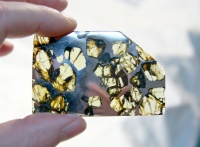Colonization of the solar system

Up: Spaceflight with gem-gum-tec
This page is about how advanced atomically precise manufacturing may be usable to colonize interplanetary space. The focus is on possibilities that are relatively near term (under a century). If more far term stuff comes up this will be especially noted.
Contents
Bodies with dense atmospheres
Atmospheres can deliver building materials in the easiest usable (do not use "digestable"!) standardized form.
- See: Air using micro ships (and macro ones).
- Gas giants
- Venus - is paradise for atomically precise manufacturing
- Titan - is Saturns only planet sized moon with an atmosphere that surpasses the one of Earth.
- Mars (the second tiniest planet) - has an rather thin atmosphere that for humans equals a full vacuum (spacesuit needed). But it is still plenty thick enough to be usable as a building material.
Asteroids in the main belt between Mars and Jupiter
- pro: enormous accessible surfacer area - probably way greater than all the planets and moons together
- pro: just the right temperature for the presence of a variety of materials
- pro: no gravity traps
- con: there is quite a bit less solar energy than on earth - but it is still enough to be useful
- con: all the material is in the solid state requiring complex mining
(well Ceres seems to have some subsurface briny water inside) - con: laggy telecommunication in a dispersed net due to light-speed runtimes
M-type asteroids
These asteroids are essentially pieces of smashed up/open proto-planetrary cores.
They are giving us the only option to physically access pretty much the same material environment that is present very very deep within out earth.
A material environment that will likely remain inaccessible even with advanced APM available. Check out the deep drilling page for details).
Setting up base at one of these asteroids would/will allow access to huge amounts siderophile elements (see Goldschmidt classification) These elements include Gold Au Platinum Pt and Iridium (among others) and are much more scarce on earth because they are highly depleted in our Earths crust.
Still, most interesting elements for large scale construction with advanced APM remain the most common ones.
Iron: First and foremost in M-type asteroids there is are huge amounts of iron.
This is presumably due to iron having the lowest energy per nucleon and thus being the "nuclear ash" final end product that cannot be further fusioned or fissioned any further.
(wiki-TODO: maybe add the classic energy per nucleon chart for illustration here)
And of course due to its high specific weight making it sink to protoplanetrary cores (aka the process of "differentiation").
- Con: Iron does not form very strong gemstones with oxygen.
- Pro: In space iron does not rust since there is no oxygen around.
- Pro: Also as a metal with an electron gas iron may feature a bit more self healing after mild radiation hits.
- Con: Pure metals such as iron are not optimal for APM but they can be used as long as some conditions are met which are:
- -- (1) for preventing surface diffusion: operation at low temperatures (e.g. far out the solar system) and/or flat surfaces
- -- (2) to prevent irreversible seamless welding: keeping nanoscale surfaces from coming too close together
Nickel: Nickel is usually mentioned as the second most common element in earths core but …
When checking out the compositions of metallic meteroids it seems that there is actually very little nickel in there and athere elements take second place.
(TODO: investigate what is going on here a bit deeper)
(TODO: list most common elements beyond iron)
Moons and dwarf planets in the outer solar system
Furter out in the solar system small bodies become increasingly icy. Water ice and at some point even nitrogen ice becomes rock forming material. If not enough carbon and silicon is present one might want to mechanosynthesize weaker bonding ices there and use those materials for not too demanding structural purposes
Flavors of diamondoid gem gum technology
Vastly differing chemical and thermal conditions at different places in the solar system could lead to differentiation (do not use "speciation"!) of diamondoid technology into very different branches.
Structures built out of water ice via cryonic inter-molecular mechanosynthesis wont find much use beside ephemeral consumables on earth since they quickly melt when uncooled or diffuse when insufficiently cooled. Further out and farther from the sun though ice and other compounds that are volatiles on earth can be seriously used as permanent building materials. This materials are also the most abundant materials in those regions so they are likely to be used.
Unlike methane water can't be safely polymerized to stuff that does not melt above 0°C. Long peroxide chains are a powerful explosives. Also oxygen polymers are un-branched linear chains and thus can't form tight meshed poly-cyclically looped covalent stiff diamondoid materials. So technology that uses only the elements oxygen and hydrogen for structural components (that is water) stays out there. Reasonably safely making explosive crystals from mostly water that do not melt will certainly be possible via mechanosynthesis since they can be made practically perfectly clean - the usefulness may be questionable.
- Chemically reducing environments (nonoxidic compounds)
- high temperature environments (refractory materials)
- metal rich environments (planetary core material in the asteroid belt)
Related
- gem gum spacesuits a special class of gem gum suits
- Telepresence robots based on multi limbed sensory equipped shells
External links
- Wikipedia: Space colonization

